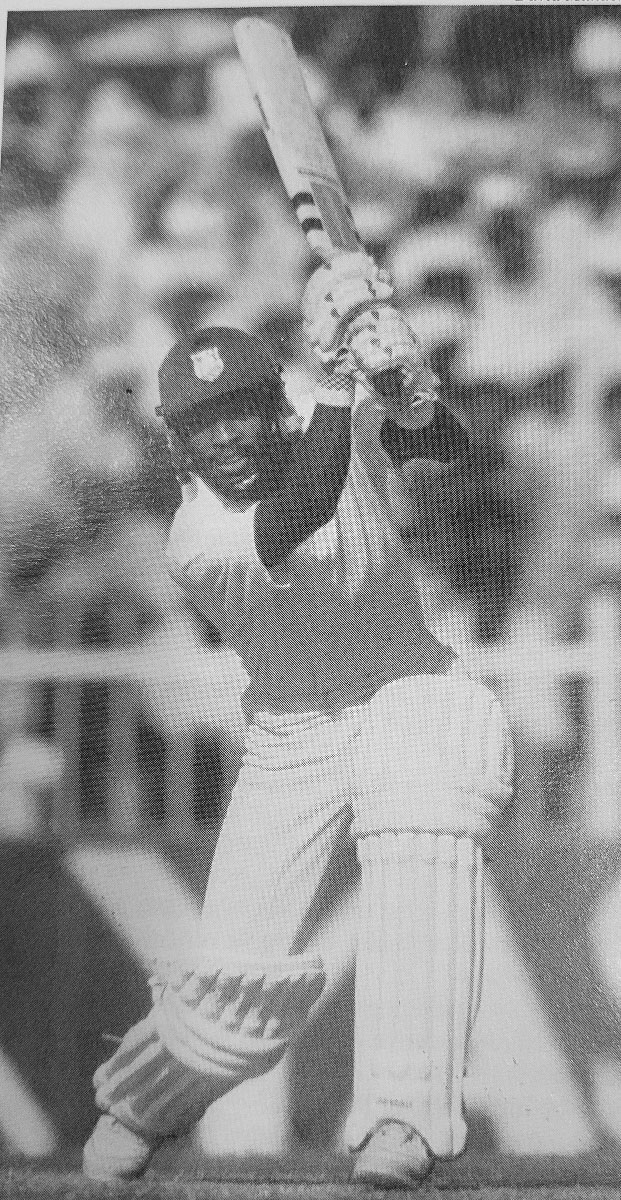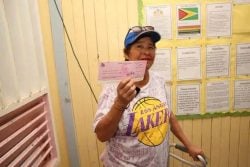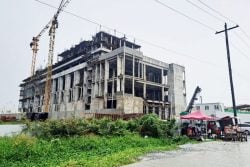In this week’s edition of In Search of West Indies Cricket, the first of two parts, Roger Seymour looks at the Test careers of Jeff Dujon and Gus Logie who were members of the West Indies juggernaut which plundered the Test arena in the 1980s. During the 1997 Northern Telecom Youth Tournament, which was hosted by Guyana, the writer had the privilege of interviewing both cricketers. The notes from the two interviews, which were misplaced whilst moving, were found a few months ago.
The interlopers
In the early 1980s – before television (which was introduced here in 1982), cell phones and the internet – the radio and the newspapers were the main sources of news. There were only two radio stations on the air then, Radio Demerara and Guyana Broadcasting Service (GBS). Both had two daily sportscasts; the former at 11:50 am and 7:55 pm, the latter at 12:15 pm and 7:15 pm. Radio Dem’s sport segments preceded the news programmes, which were read on the hour, whilst at GBS, sports followed the news bulletin.
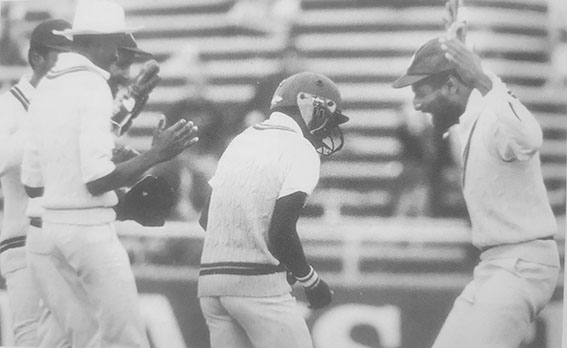
(centre) during the Second Test at Auckland, New Zealand, 1987. Logie took eight catches in the
drawn three-match series. (Source: 1987 Benson & Hedges West Indies Cricket Annual)
At lunch time, we often listened to both sportscasts to ensure that we were updated on all matters. In early September 1981, we anxiously awaited the start of Radio Dem’s midday edition since the West Indies team for the 1981/82 Australia Tour was going to be announced. Then sports editor, the famous B L Crombie, who read at rapid-fire pace, after his routine intro, rattled off the names of the selected players. The team read; Clive Lloyd (Captain), Viv Richards (Vice Captain), Steve Camacho (Manager), Faoud Bacchus, Sylvester Clarke, Colin Croft, Jeff Dujon, Joel Garner, Larry Gomes, Gordon Greenidge, Desmond Haynes, Michael Holding, Harold Joseph, Gus Logie, Malcolm Marshall, David Murray, Andy Roberts, and Dennis Waight (Trainer/Physiotherapist).
I scribbled their initials, hopelessly trying to keep pace with Crombie’s staccato delivery. My father and I exchanged furtive glances after Crombie completed the list of players. “Didn’t hear Kallicharran’s name, did you?” I mumbled in utter disbelief.
“Maybe in his haste, BL missed it,” my father tried to assuage my fears.
We listened to the news in silence – in those days it was almost sacrilegious to speak during the news and death announcements. We switched the channel to GBS, and my mother was conscripted to take the names in shorthand. Same list. No Kallicharran. I was speechless, numb. Roberts had broken one of Kalli’s fingers in the Guyana/ Leeward Islands Shell Shield match in early February at Queen’s Park, Grenada, and he had missed the home series against England. Jamaican Everton Mattis, who had batted in the number four slot in the four Tests – one was abandoned 9In Search of West Indies Cricket, ‘The Test that Never Was’, 5 & 12, June, 2016) – hadn’t seized the opportunity, and also missed the cut. Who were these middle-order interlopers, Jeffrey Dujon and Gus Logie?
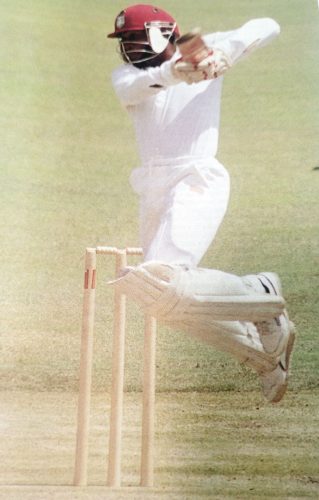
During the 1997 Nortel Youth Tournament, which was hosted by Guyana, I met Gus Logie at the Leewards and Windwards match, 17 – 19 August, at La Bonne Intention (LBI) Community Centre Ground, East Coast Demerara. At the time, Logie, the West Indies Youth Team Coach, was scouting the game as a selector for the West Indies team for the 1997 Youth World Cup to be held in South Africa. Logie had previously served in a similar capacity for the WI Under-19 team to Pakistan and Bangladesh in 1995.
Here are excerpts from the interview which was conducted in late August at the Pegasus poolside. In between moments of deep thought and spontaneous laughter, Logie spoke about his life in cricket. Questions on selection policy were off limits.
Always a South boy
RS: What were early days in cricket like?
GL: “I am from Sobo, a small village in South Trinidad, and basically as kids, we played cricket from January to June, and soccer from July to December. I came under the guidance of Willie Guadeloupe, who was the coach for South/West in the Wes Hall Youth League. He was a disciplinarian who emphasised hard work and discipline. He wanted us to be ‘professional amateurs’ and he focused a lot on physical preparation. We did so much running, people thought we were training for the Olympics [laughter].”
RS: “At the same time you were also playing club cricket?”
GL: “Yes, at the age of 13, I began playing for Texaco-Brighton in the Third Division.”
RS: “Which has been your only club?”
GL: “Yes. As a young player nobody wanted to invest in an unknown quantity, saying it was too far from south to north [Port-of-Spain]. People are reluctant to make that kind of investment when you are nothing. As soon as I made the Trinidad and Tobago team they were interested. All I had to say was that the distance from south to north hasn’t changed, for which I have never been forgiven, up to this day.”
RS: “At which position did you bat at youth level?”
GL: “I started out as an offspinner, batting at number eight. I then decided to focus on my batting, and by the next year, I was batting at three, when I captained the side.”
RS: “Your transition from West Indies Youth player to WI Under-26 [to Zimbabwe, in 1981] to the WI Test squad was rapid [within two years]. Were you surprised when you were selected to go to Australia for the 1981/82 Tour?”
GL: “No, I wasn’t. I had scored 125 versus Barbados [at the Queen’s Park Oval, Trinidad] in the [1981]Shell Shield, off an attack that included Sylvester Clarke, Malcolm Marshall, Joel Garner and Albert Padmore [all Test cricketers], and I distinctly remember Joel coming into our dressing room [afterwards], and saying to me, ‘Young man you just booked your place to Australia.’ [Logie’s scores in the 1981 Shell Shield were: 56 in Jamaica, 10 versus the Combined Islands, dismissed by Andy Roberts, 64 in Guyana, and 125 & 3* vs Barbados, as Trinidad won by eight wickets, their sole victory]. Actually, I was in New York when I heard I was selected.”
RS: “New York?”
GL: “Yes, I had had a problem with my shoulder, and a friend had recommended that I go to New York to see a chiropractor. I was aware of Alvin Kallicharran’s shoulder problem [Bursitis] and wanted an alternative to an operation. Whilst there I played for the Excelsior Club in the Metropolitan League on weekends, and their president arranged for me to see a chiropractor thrice a week for six to eight weeks. Since then I have never had a problem with it. I have always had a special feeling for those people in New York, and I went back every summer for five more years to play for Excelsior.”
RS: “As a kid, did you ever see yourself playing for the West Indies?”
GL: “Yes, I remember as a kid telling my mom that I had dreamt of playing in front of large crowds and that my bat would mind one day …[loud laughter] …I didn’t even own a bat at the time. But I never envisioned rubbing shoulders with the likes of Clive, Viv, Andy, Mikey, so soon.”
RS: “Your arrival at Test level?”
GL: “Joel took me under his wing. I remember the first morning in Australia he came to my room at 5.15 am: ‘Young man, we are going for a run’. We went for a run around a lake in Adelaide. It was very cold, and a photographer, already out, snapped a picture of us together and the next day’s newspaper had us under the caption, ‘The Long and Short of It’ [loud laughter].”
Garner is 6’ 8’’, Logie is 5’ 4’’.
RS: “Your Test average does not reflect what your true worth to the side was. Batting up and down the order [3, 4, 5, 6], and being in and out of the side initially, may have contributed to this?”
GL: “The West Indian team was like a theatre drama. There were superstars, stars and role players. I accepted my role as that of a supporting one. We had a camaraderie, which I miss, and a one for all, all for one attitude. I enjoyed making the sacrifices, whatever they were, for the team.”
RS: “It was an absolute joy just to watch you field.”
In two to three strides Logie would be flying at top speed, a sight to behold, as he chased every ball to the boundary.
GL: “Fielding is a beautiful part of the game. I always told my roommate Gordon [Greenidge] you bat, I’ll field. My coach Willie Guadeloupe always felt that the outcome of a game was going to hinge on the standard of fielding. If you can save 30 to 40 runs in the field that would give you a distinct advantage over the other side.”
RS: “You were brilliant in the covers, and later became just as outstanding under the bat.”
GL: “That was by chance. Desmond [Haynes] hurt his finger in New Zealand and we needed someone to volunteer. I did and it just developed from there. I put in a lot of practice, and developed my own style, with one foot forward, and the other slightly backward, and rocking back and [forward], and it grew from there.”
RS: “For a small man – 5’ 4’’, 135 lb – you hit the ball extremely hard.”
GL: “I don’t know if I can be compared to such power hitters as Gordon, Viv and Clive. I do remember hitting Rodney Hogg [Australian fast bowler] for a six in a one-day game at Melbourne, over mid-on that went four or five rows into the stands. A spectator later put up a sign on the spot: 6 ½. [laughter].”
RS: “You developed a reputation for discipline, often being the first on the bus.”
GL: “My mum, the biggest influence on my life – my father died when I was nine years old – had always brought me up with good discipline.”
RS: “Who were your toughest opponents?”
GL: “Individually, Richard Hadlee, he could bowl a perfect line and length all day. Sunil Gavaskar, Javed Miandad, Greg Chappell, Allan Border and Kapil Dev, were all great players who never gave anything away. Teams? The Australians. Their approach has always been both systematic and scientific. They are always planning ahead for you. Studying videos and data on their opponents, hanging the rules and preparing pitches to their advantage.”
RS: “It is felt in many quarters that you retired from Test cricket too soon. You were only 32 at the time.”
GL: “At the end of the day it doesn’t matter what you achieve there’s always more. Success to me is not about making runs or taking wickets, it’s what you make of yourself. I guess we are not accustomed to people quitting, and we tend to focus too much on the money sometimes. Cricket was never more important than my family, and I wanted to spend more time with my wife Lisa and our two boys, Giovan and Aaron.”
RS: “Worst moment?”
GL: “Losing the 1983 World Cup Final to India. [Logie was a member of the 14-man squad but didn’t play.] I saw big men crying openly. It was a hard lesson for a youngster to learn. It showed how much it meant to be a West Indian player. We were representing a nation of West Indian people, not just back home but the world over. It became more than a game of cricket. It went way beyond the boundary.”
RS: “Your career in coaching. You have coached in Australia, the WI Under-19 Team in Pakistan and Bangladesh, and the WI ‘A’ Team in Sri Lanka last year. What is your present status?”
GL: “I am a certified coach [English National Cricket Academy accreditation] and have coached in Australia for three seasons [92 – 95 , Prospect Club, Adelaide]. At present I have a three-year contract with the WICBC, but mainly to help the Under-15s, the Under-19s, and the ‘A’ Team. I have assisted the Windwards at the Under-15 Level, and have advised St Kitts with developing a curriculum for their academy programme.
“Coaching is not about stifling young people but rather encouraging and helping them to improve. Hopefully, we can develop not only good cricketers but good human beings.”
RS: “Where do you see yourself in five years?”
GL: “Hopefully assisting in the development of the game through coaching.”
RS: “Do you have any regrets?”
GL: “I would have liked my father to have seen me play Test cricket, and I wished my mother had lived longer [she passed in ‘91] to reap the rewards of her many sacrifices. [Logie is the last of ten siblings.]”
RS: “Have we missed anything?”
GL: “Yes, I would like to thank God for my talent, and the many people who assisted me with their support and advice. The WICBC, the selectors, the captains I played under, the players and the public for their support.”
RS: “Thank you very much for your time. Final question, where do you live now in Trinidad?”
GL: “In La Brea, not too far from Sobo, about five-six kilometres. I’ll always be a South boy.”
